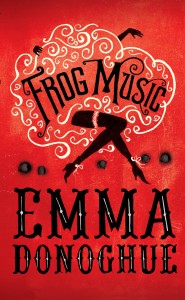The Magic of Frog Music
by Claire Morris
 Emma Donoghue discusses her latest novel.
Emma Donoghue discusses her latest novel.
The gold rush is over, and San Francisco is growing into the eclectic Californian city we know today. In the 1870s, people are moving there from across the globe, and Blanche Beunon is among them. Leaving Paris’s Cirque d’Hiver, she establishes herself as a dancer in the House of Mirrors, entertaining many of its patrons after-hours, using this income to keep her companions Arthur and Ernest fed and clothed in the best bohemian style. But during a smallpox epidemic, she meets Jenny Bonnet, who, in the words of author Emma Donoghue, is “a risk-loving, cross-dressing, quirky young woman who live[s] as if she knew she’d only get 27 years.”
Jenny is inquisitive, and her questions over a shared meal of frogs’ legs make Blanche examine her life choices. When Jenny is shot to death, Blanche embarks on a quest that involves both survival and justice.
This is the premise of Donoghue’s latest novel, Frog Music (Little Brown and Picador, 2014), which is comprised of two intricately woven stories: that of Blanche’s life immediately after Jenny’s murder, and what happened in the weeks leading up to the murder.
Frog Music contains the deft storytelling, graphic prose, and lifelike characterization that Emma Donoghue has become known for through novels such as international bestsellers Room (Little Brown, 2010) and Slammerkin (Virago, 2000). I was transported deep into the lives of Blanche, Jenny, Arthur and Ernest, who, along with most of the other characters in this novel, really lived.
Donoghue tells me she knew she had to write a novel about Jenny Bonnet when she discovered her in Autumn Stephens’ Wild Women about 15 years ago. It was not only the sense of Jenny’s character that compelled her, but also post-Gold-Rush San Francisco, which she describes as “self-consciously diverse and proud of its eccentrics”.
The novel’s title refers to what Donoghue calls “the sound a large horny chorus of frogs makes when they want to mate” (Jenny caught frogs in the ponds around San Francisco and supplied them to French and Chinese restaurants), but also alludes to the French immigrants who are central to this story. Because of their performing background, music is ever-present. Blanche and Jenny are often humming tunes, and a reference section on these is included at the book’s end. Naturally this use of period lyrics adds wonderfully to the atmosphere.
“I knew my main characters all had a performing background in circus/burlesque,” Donoghue explains, “so music seemed an obvious way to suggest that, but I came to rely more and more on the tangled knot of folksong (in the broadest sense) that would have been heard in 19th-century California, for suggesting not only the different cultural groups who made up that society, but how promiscuously they rubbed up against each other.”
Music is just one element the author employs to convey a convincing sense of time and place. The details of Blanche’s home in Chinatown, the various establishments she frequented, the saloon outside the city where Jenny died, and the institutions where parents left children in often dubious care provide a believable image of San Francisco 140 years ago. Donoghue used census information, municipal records, guidebooks, memoirs, photographs and other material to build up a picture of the city at that time in her own mind, which she then shares with readers through descriptive sentences such as: “This quarter’s always filthy – mostly because the City Supervisors won’t fix its sewers or pay for garbage collection. Arthur claims to relish it: skirting piles of fishtails makes him feel like a true bohemian.”
I asked Donoghue what she’s working on now. “A children’s book,” she told me. A new genre for her, but one in which we know she’ll excel.
About the contributor: Claire Morris was the managing editor of Solander from 2004 to 2009, and currently serves as features editor for the HNS website. She is also the principal of Claire Morris Strategic Writing & Editing, www.claireonwriting.com
______________________________________________
Published in Historical Novels Review | Issue 68, May 2014






